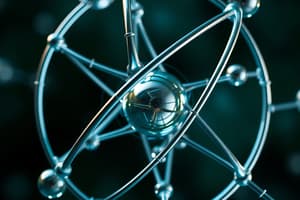Podcast
Questions and Answers
Which of the following is an example of a homogeneous mixture?
Which of the following is an example of a homogeneous mixture?
- Granite
- Vegetable soup
- Orange juice with pulp
- Saltwater (correct)
Sublimation is the process where a substance changes directly from a liquid to a gas.
Sublimation is the process where a substance changes directly from a liquid to a gas.
False (B)
What is the SI unit for temperature?
What is the SI unit for temperature?
Kelvin
The number of ______ determines the identity of an element.
The number of ______ determines the identity of an element.
Match the following terms with their correct descriptions:
Match the following terms with their correct descriptions:
Flashcards
Homogeneous vs. Heterogeneous Mixtures
Homogeneous vs. Heterogeneous Mixtures
Homogeneous mixtures have uniform composition throughout (e.g., saltwater). Heterogeneous mixtures do not have uniform composition (e.g., salad).
Phase Changes
Phase Changes
Sublimation is solid to gas. Freezing is liquid to solid. Boiling is liquid to gas. Melting is solid to liquid.
Atomic Number vs. Mass Number
Atomic Number vs. Mass Number
Atomic number is the number of protons. Mass number is the total number of protons and neutrons.
Ionic vs. Covalent Bonds
Ionic vs. Covalent Bonds
Signup and view all the flashcards
Physical vs. Chemical Changes
Physical vs. Chemical Changes
Signup and view all the flashcards
Study Notes
- This is a review for the midterm exam in College Preparatory Chemistry (CHEM 010) for Spring 2025 at Bahamas Baptist University College
Topics to Review
- Matter can be classified as homogeneous or heterogeneous mixtures; learn to identify examples of each, including pure substances
- Phase changes include sublimation, freezing, boiling, and melting; understand the definitions of each and be able to provide examples
- Atomic structure includes the atomic number, mass number, and subatomic particles, which are protons, neutrons, and electrons
- Periodic table basics include knowing the chemical symbols for common elements and how elements are arranged by atomic number
- Bohr model explains energy levels and electron distribution within an atom
- Matter can be classified as compounds or mixtures; know the difference between physical and chemical properties
- Physical changes and chemical changes should be understood with examples of each type
- The SI unit for temperature is Kelvin; be able to perform common conversions
- Valence electrons are the number of valence electrons in key elements and their role in bonding
- Types of bonds include ionic and covalent bonds; be able to provide examples
- Physical and chemical changes have specific definitions, examples, and distinguishing characteristics
- Unit conversions can be performed using the Factor Theory Method
- Atomic structure table includes its use to understand atomic number, mass number, and particle counts for elements
- Electron configuration is writing electron configurations for common elements
- Density calculations include the formula (Density = Mass / Volume); practice solving problems using this formula
- Dalton's atomic theory includes learning the key postulates and importance in modern chemistry
- Chemical bonds are the definitions and examples of ionic and covalent bonds and the role of valence electrons in bonding
Study Tips
- Review lecture notes and textbook readings
- Practice solving conversion problems
- Memorize periodic table trends and element properties
- Create flashcards for key definitions and concepts
- Take practice quizzes to test understanding
Studying That Suits You
Use AI to generate personalized quizzes and flashcards to suit your learning preferences.
Related Documents
Description
Review material for the CHEM 010 midterm, covering matter classification (homogeneous/heterogeneous mixtures, pure substances), phase changes, and atomic structure. Key topics include the periodic table, Bohr model, physical/chemical properties, and SI units.



